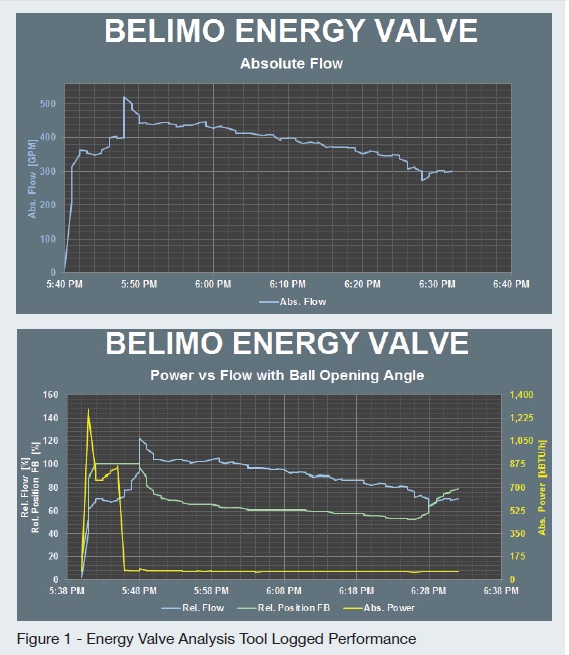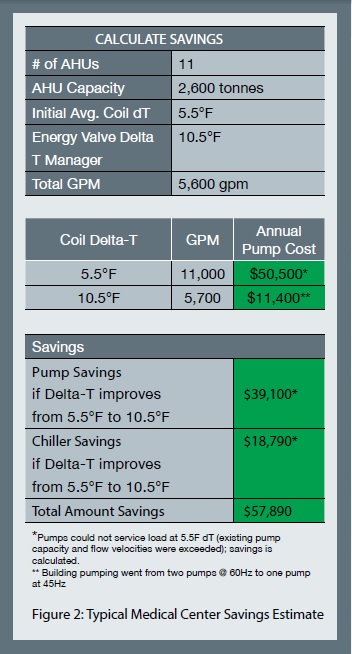The University of Miami’s medical campus saved thousands of dollars and increased plant capacity with the Belimo Energy Valve retrofit. We bring you the case study…
INTRODUCTION
Most large campuses or buildings have a central plant with chillers and boilers generating cold and hot water throughout the buildings for occupant comfort. The chiller and boiler equipment after initial commissioning often operates at lower efficiency than intended in design. The reason is inefficient heat transfer in the room units and valves away from the plant. Increasing their performance will translate into more efficient operation in the central plant, saving energy and cost.
THE BACKGROUND
University of Miami’s Leonard M Miller School of Medicine was paying very high operating costs from chiller and pumps working overtime. It was determined by US-based Kerney and Associates and confirmed by data from the Belimo Energy Valve that this was a Low Delta T problem, causing inefficient chiller plant and pump operation.
The installation of the Belimo Energy Valve with its patented Delta-T-Manager increased Delta T from -14.16 degrees C (6.5 degrees F) to -11.94 degrees C (10.5 degrees F). This increase in delta T produced reductions in chiller and pump operating costs of USD 66,000 annually.
THE CASE STUDY
The problem:
At the heart of the university is a 47,000-square-foot chiller plant with 12,000 tonnes of installed capacity. While the chiller plant was fairly new, having opened in 2011, some buildings on the campus were not operating as efficiently as they could, wasting thousands of gallons of chilled water. However, the problem was not with the chiller plant but the cooling coils in several of the campus facilities.
The diagnosis – Low Delta T syndrome:
Each valve has a static IP address, allowing technicians to check delta T readings and flow efficiency at the valve in real time
Low Delta T, a common mechanical illness was found to be at the root of the problem. It occurs when air-handling coils are oversized, demand too much water or foul and degrade with age. Poor system water balance and improperly installed and controlled air-handlers can also contribute to Low Delta T. When this happens, air-handler efficiency and heat transfer plummets. In turn, chillers and pumps work overtime in order to maintain a given temperature set-point. Return water temperature to the chiller is lower than the intended design, forcing more water to be pumped through the system. As more and more gallons of water move through the system, not only is efficiency in question, but utility costs can go through the roof. This was the diagnosis for some of the buildings on the University of Miami’s medical campus. Even with a new chiller plant, and a mix of new and older facilities, Low Delta-T was negatively impacting the efficiency on campus.
Kerney and Associates of Dania Beach, Florida, a specialty piping and energy services company, who also specialise in retrofits, stepped in.
The solution:
Kerney and Associates suggested the use of Belimo Energy Valve, which is a pressure-independent valve that optimises and documents water coil performance. It includes an electromagnetic flow sensor and temperature sensors that monitor supply and return water. Differential temperature is monitored to make sure that the delta T across the valve is performing at the desired set-point. If delta T drops, the valve modulates the flow of water at the coil, which improves system efficiency. To make sure that the valve and the coils are working as specified, the valve also has BACnet capabilities. Each valve has a static IP address, allowing technicians to check delta T readings and flow efficiency at the valve in real time.

Figure 1: Energy Valve Analysis Tool Logged Performance
Results:
To prove that the Energy Valve could do what it was designed to do, Scott Czubkowski, PE, Director of Engineering at Kerney Associates, installed the valve at the university’s Clinical Research Building. On an average, the building was seeing a -13.88 degrees C (7 degrees F) delta T and inefficient energy transfer. An Energy Valve was installed on a 175- tonne heat exchanger that was transferring energy at a -15.83 degrees C (3.5 degrees F) delta T. The results were verified using Data Analysis Tool that imports up to 13 months of data stored in the valve actuator. The data includes absolute flow, absolute power and temperature. All of these components can then be compared and analysed to see improvements in the system. Czubkowski found that when the Belimo Energy Valve was installed, the system reacted almost immediately. At the initial start-up of the valve, the heat exchanger’s delta T was at -15.83 degrees C (3.5 degrees F) with a gallon per minute (GPM) reading of 520. In less than an hour, the Energy Valve Delta-T- Manager took over control of the coil, and the delta T rose to -14.16 degrees C (6.5 degrees F) and the flow was reduced to 300 GPM. (See Figure 1.) The flow-rate continued to drop as the day went on. As heat exchanger performance increased, the entire building saw an improvement in delta T.
[div class=”text-box text-box-right” style=”background-color: #898989; color: #FFFFFF; “]
The aim was to improve system performance, reduce plant operation cost and increase plant capacity. Installing Belimo Energy Valve with its patented Delta-T-Manager helped:
• Increase plant capacity by optimising pump and chiller usage.
• Monitor coil system performance to help quantify changes (improvements) in the system. The increase in delta T produced reductions in
The increase in delta T produced reductions in chiller and pump operating costs of USD 66,000 annually.
[end-div]
Kerney and Associates also found that within an hour, the system went from using 600 GPM to 100 GPM. With those kinds of immediate results, Czubkowsi said that Ron Bogue, Assistant Vice President for Facilities and Services at the University of Miami’s medical campus, was able to validate that the technology worked.
The university decided to purchase more Energy Valves to find out what kind of impact they could they on an older building.
Replicating the results:
Czubkowski and his team tested the valve on the university’s 450,000-square-foot, 35-year-old Rosenstiel Medical Science Building. Czubkowski illustrates in Figure 2 the savings from the building. Eleven major air-handling units (AHUs), at 30,000 cfm each, serve the building. Some of the air-handling equipment is almost as old as the building itself, and the air-handling coils of the AHUs had degraded over time. Delta T was hovering around -13.88 degrees C (7 degrees F) or -13.33 degrees C (8 degrees F), which meant that the system was wasting thousands of dollars in energy. With the Belimo Energy Valve installed, the Rosenstiel Building started to see a delta T of -11.94 degrees C (10.5 degrees F).

Figure 2
CONCLUSION
Installing Energy Valve helped improve building plant performance and transparency, while reducing operating and maintenance costs at the University of Miami’s medical campus.
According to preliminary calculations, Kerney and Associates believes that the University of Miami will see a three- to four-year payback on the valves it purchased for the Rosenstiel Building. Each of the 11 valves installed should create an approximated USD 5,000 utility savings, bringing the total annual savings cost to an estimated USD 57,890. And Bogue and his mechanical team can make sure that facilities, such as the Rosenstiel Building continue to save on utility costs and keep adequate delta T readings. As part of its preventative maintenance initiative, Bogue frequently checks the valve performance in the buildings by using the BACnet capabilities. If delta T readings go under an intended set-point, an alarm goes off to notify the mechanical staff that there is a problem.
The results have prompted the University of Miami to continue installing the Belimo Energy Valve. Work is scheduled to install the valves at two more campus buildings. First on the list is the Batchelor Children’s Research Institute. The building will install four Energy Valves to control a 1,000-tonne chiller load. The newest building, the Biological Building, will also adopt the Belimo Energy Valve technology. The building also boasts of the largest AHUs on campus. When the air handlers are retrofitted, the university expects that the building will operate as intended, and not waste chiller water.
CPI Industry accepts no liability for the claims expressed in this article, or for the consequences of any actions taken on the basis of the information provided here.
Copyright © 2006-2025 - CPI Industry. All rights reserved.